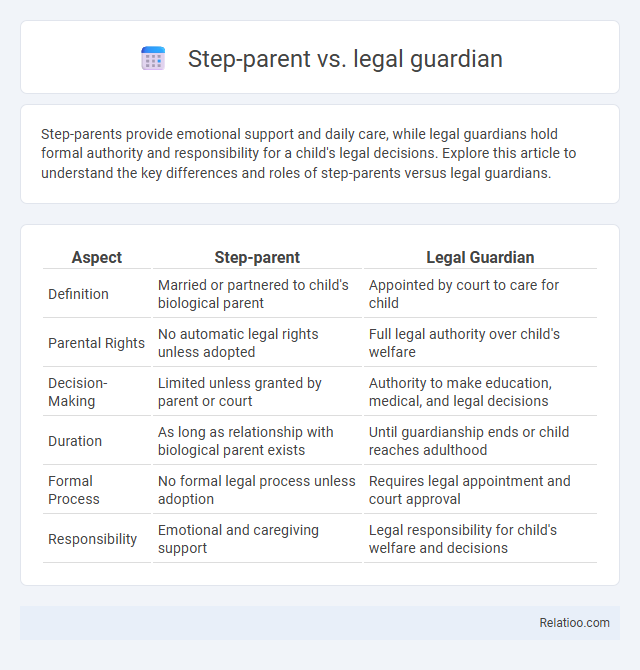Step-parents provide emotional support and daily care, while legal guardians hold formal authority and responsibility for a child's legal decisions. Explore this article to understand the key differences and roles of step-parents versus legal guardians.
Table of Comparison
| Aspect | Step-parent | Legal Guardian |
|---|---|---|
| Definition | Married or partnered to child's biological parent | Appointed by court to care for child |
| Parental Rights | No automatic legal rights unless adopted | Full legal authority over child's welfare |
| Decision-Making | Limited unless granted by parent or court | Authority to make education, medical, and legal decisions |
| Duration | As long as relationship with biological parent exists | Until guardianship ends or child reaches adulthood |
| Formal Process | No formal legal process unless adoption | Requires legal appointment and court approval |
| Responsibility | Emotional and caregiving support | Legal responsibility for child's welfare and decisions |
Understanding the Roles: Step-parent vs Legal Guardian
Step-parents often provide emotional support and daily care but lack automatic legal authority over the child unless legally adopted. Legal guardians hold formal responsibility granted by the court to make decisions about the child's welfare, education, and healthcare. Primary caregivers are those who consistently provide everyday care, which may or may not align with legal guardianship or step-parent status.
Legal Definitions and Distinctions
Legal definitions distinguish a step-parent as an individual married to a child's biological parent without inherent parental rights unless formally adopted or granted guardianship. A legal guardian is appointed by a court to assume responsibility for the care and decision-making of a minor, holding legal authority similar to that of a biological parent. The primary caregiver is recognized based on the practical role in a child's daily care and upbringing but may lack formal legal rights unless granted through guardianship or custody arrangements.
Parental Rights and Responsibilities
Step-parents generally do not have automatic parental rights or responsibilities unless they legally adopt the child or obtain court-approved guardianship. Legal guardians possess full parental rights and responsibilities, including decision-making authority for the child's welfare, education, and healthcare, as granted by a court. Primary caregivers may have day-to-day responsibilities but lack legal parental rights unless formally recognized through guardianship or adoption.
Custody and Decision-Making Authority
Step-parents typically do not have automatic custody or legal decision-making authority unless they formally adopt the child or obtain guardianship through court approval. Legal guardians hold comprehensive custody rights, including authority over medical, educational, and welfare decisions, recognized by law to act in the child's best interest. Your primary caregiver may manage daily care and routine decisions, but without legal custody, they lack the full legal power to make major decisions affecting the child's future.
Inheritance and Financial Implications
Step-parents typically do not have automatic inheritance rights unless legally adopted or named in a will, while legal guardians hold fiduciary responsibilities that may include managing a child's inheritance and financial matters. Primary caregivers, although responsible for daily child support and welfare, generally lack formal inheritance rights unless granted legal guardianship or included in estate plans. Your estate planning should clearly designate beneficiaries and guardians to ensure intended financial provisions and inheritance protections.
Marriage and Family Dynamics
Step-parents, legal guardians, and primary caregivers each play distinct roles in marriage and family dynamics, influencing parental responsibilities and emotional bonds. A step-parent typically gains familial authority through marriage but may have limited legal rights compared to a legal guardian, who holds formal responsibility for a child's welfare independent of marital status. Your understanding of these roles is crucial for navigating custody arrangements, decision-making authority, and the evolving relationships within blended families.
Adoption vs Legal Guardianship
Adoption establishes a legal parent-child relationship granting full parental rights and responsibilities, unlike legal guardianship, which provides temporary or long-term care without severing biological parental rights. Step-parents typically do not have legal authority over a child unless they pursue adoption or are granted guardianship by the court. Primary caregivers, often biological or legal guardians, provide daily care and decision-making for the child but may lack full legal parental status without formal adoption or guardianship.
Impact on the Child’s Welfare
Step-parents, legal guardians, and primary caregivers each play distinct roles with varying impacts on a child's welfare. Legal guardians hold recognized authority over the child's decisions and well-being, often ensuring stability and access to resources; primary caregivers provide daily emotional support and meet the child's essential needs, directly influencing their development and security. You should understand how each role contributes differently to your child's emotional health, legal protection, and overall growth.
Court Processes and Legal Requirements
Step-parents seeking legal recognition must often navigate court processes such as stepparent adoption, which requires terminating the non-custodial parent's rights and proving the step-parent's ability to provide a stable environment. Legal guardianship involves formal court appointments granting decision-making authority over a child when parents are unable or unwilling to do so, typically requiring background checks, home evaluations, and petitions demonstrating the child's best interest. Primary caregivers may lack automatic legal rights without custody or guardianship orders, necessitating court intervention to establish formal recognition through custody agreements or guardianship petitions to secure rights and responsibilities.
Choosing the Right Role for Your Family
Choosing the right role for your family depends on the level of responsibility and legal authority you seek; a step-parent often provides emotional support and daily care without automatic legal rights, whereas a legal guardian holds formal rights to make decisions on behalf of the child. A primary caregiver typically manages the child's daily needs and well-being but may not have legal decision-making authority unless designated as a guardian. Understanding these distinctions ensures that your family selects the role that best aligns with your caregiving responsibilities and legal considerations.

Infographic: Step-parent vs Legal guardian
 relatioo.com
relatioo.com